
Germanic woman raped and beaten by Allied Forces.
Hellstorm
Transcript from the online documentary Hellstorm; an alternative, fact based account of events both before and after World War Two based on the best selling book Hellstorm by revisionist historian Thomas Goodrich
- Terror Bombing
- The Rape of Germany
- The Baltic Massacre
- Defeat in the West
- Death Camps
- The Purge
- Ethnic Cleansing
- Conclusion
The German Army suffered terribly during the First World War. And the German nation also suffered terribly, especially after the war. The crippling sanctions enacted by the victors with the Treaty of Versailles threw the country into serious depression. There was chaos in the streets and anarchy in the air. Communists seized many cities, including Berlin. While the great wealth of the nation was bled away by outrageous war reparations, or sucked out by unscrupulous politicians, the average German was impoverished.
Inflation and unemployment soon followed and quickly destroyed all hope, all confidence, all morality. German cities were awash in pornography and prostitution, with even starving children being bought and sold like sex toys. Crime was rampant; drunkenness and drug addiction were widespread; suicide rates soared; the situation seemed hopeless. And then, things changed… dramatically.
Soon after the National Socialists were elected, the German economy sprang to life. Unemployment was erased. Building boomed. Great projects began. Confidence burst to life anew. After years of hunger, hardship, shame, and degradation, Germany became a happy, hopeful nation again.
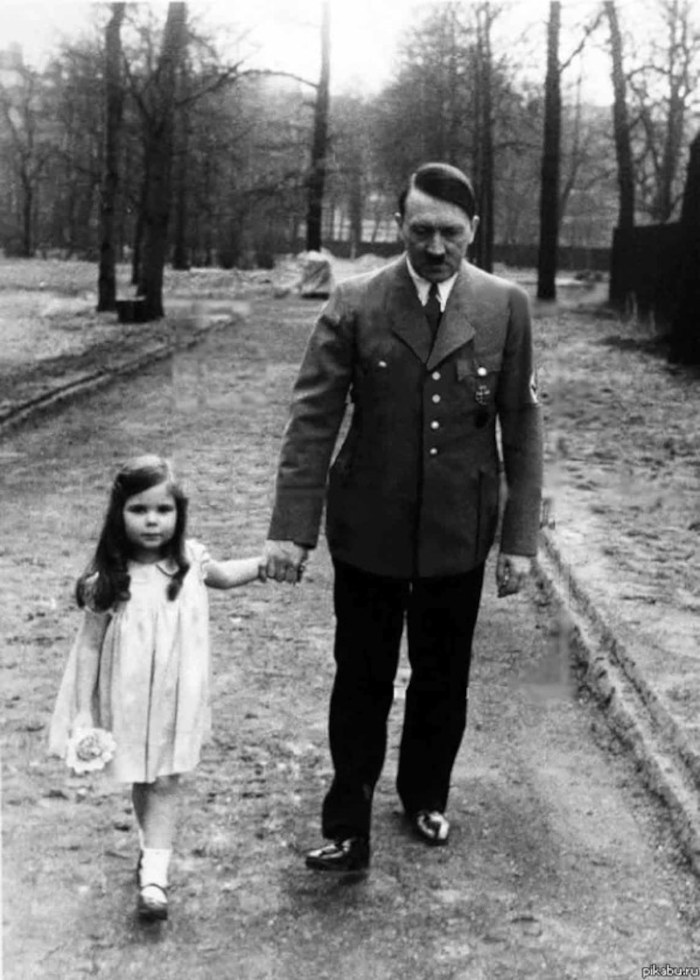
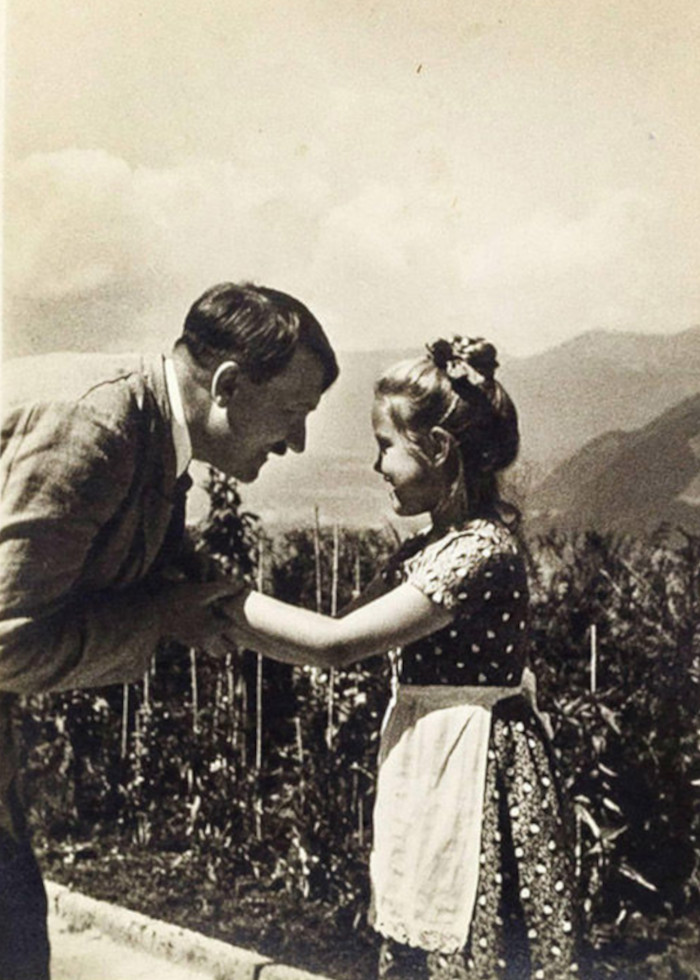
Germany's transformation from squalor and misery to a world superpower was so incredible that the 1938 Time Magazine named Adolf Hitler “Man of the Year.” To many it seemed as if a new cultural, economic, and political renaissance for all of Europe was at hand. But others, throughout the world — envious, powerful, but above all, fearful — now worked night and day to take Germany down….
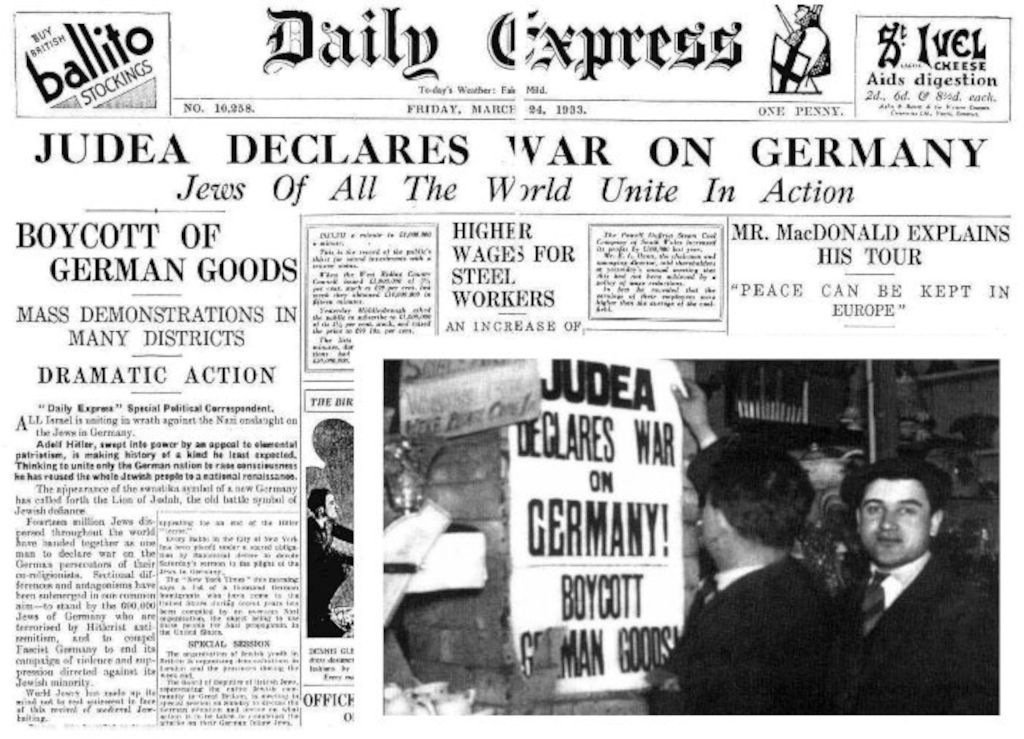
The Second World War was the most deadly and destructive war in history. For six long years the unequal struggle pitting Germany against the world continued, with first one side, then the other on top. But at last, overwhelmed, Germany was once more defeated.
This time, however, the Reich was to be punished not with mere reparations… nor loss of land… nor with simple decadence and despair; no, on this occasion Germany was to be subjected to pure hatred; hatred of the most vicious, evil and depraved kind imaginable. Millions upon millions of Germans, many of whom had nothing to do with the war, were systematically raped, tortured, slaughtered, and all in the most sadistic and sickening ways imaginable. What happened to Germany and its people during and after World War II has remained the darkest and best-kept secret in world history… until now. This film is based upon the book by author and historian, Thomas Goodrich.
Over the past thirty years Goodrich has written about a number of controversial subjects — the American Civil War, Abraham Lincoln, the American Indian wars — but because World War Two remains to this very day a pressing issue, the author feels this is by far his most urgent and timely book.
Thomas Goodrich: This is the story of the crimes that were committed against Germany during and after World War Two. The words you will hear are those of the victims themselves and witnesses to the atrocities. There will be no attempt here to present the viewpoint of the “other side.” Anyone seeking the victor's version of World War II, need only watch any Hollywood movie, turn on the TV to any World War II documentary, or visit any public library. This film, like the book it is based upon, does not concern itself with what the Germans allegedly “did to the world” during the so — called “Good War.” No. The focus here is instead on what the world did to the Germans.
The crimes detailed herein are so vicious, so massive, and so evil, that there are no words in the English language to accurately describe them. These are crimes that have been buried by the victors under a mountain of propaganda and lies for now over 70 years. This film is dedicated not only to the voiceless victims of the world's worst war, but also to future generations. Our hope is, that if there are enough good people in the world, are willing to listen and learn what actually occurred to these innocent victims — men, women, the old, young, the sick, animals — then they some day soon will rise up as one, and with a united voice demand that nothing like this ever happens again, to anyone, anywhere.
TERROR BOMBING:
During World War Two, Germany was subjected to an unrelenting assault from the sky. The Americans and British called it “carpet-bombing”, “saturation-bombing”, or “unrestricted-bombing”. However, the German women and children who suffered through this nightmare called it by a simpler, more accurate name — “Terror-Bombing.” The terror campaign was no accident. It was the secret plan of British Prime Minister Winston Churchill and Air Chief Marshal Arthur Harris to unleash the full power of the Royal Air Force against German civilians; to inflict as much damage, to destroy as many homes, and to kill as many men, women, and children as possible. Winston Churchill: German cities will be subjected to an ordeal the like of which has never been experienced by a country in continuity, severity, or magnitude. To achieve this end, there are no lengths of violence to which we will not go.
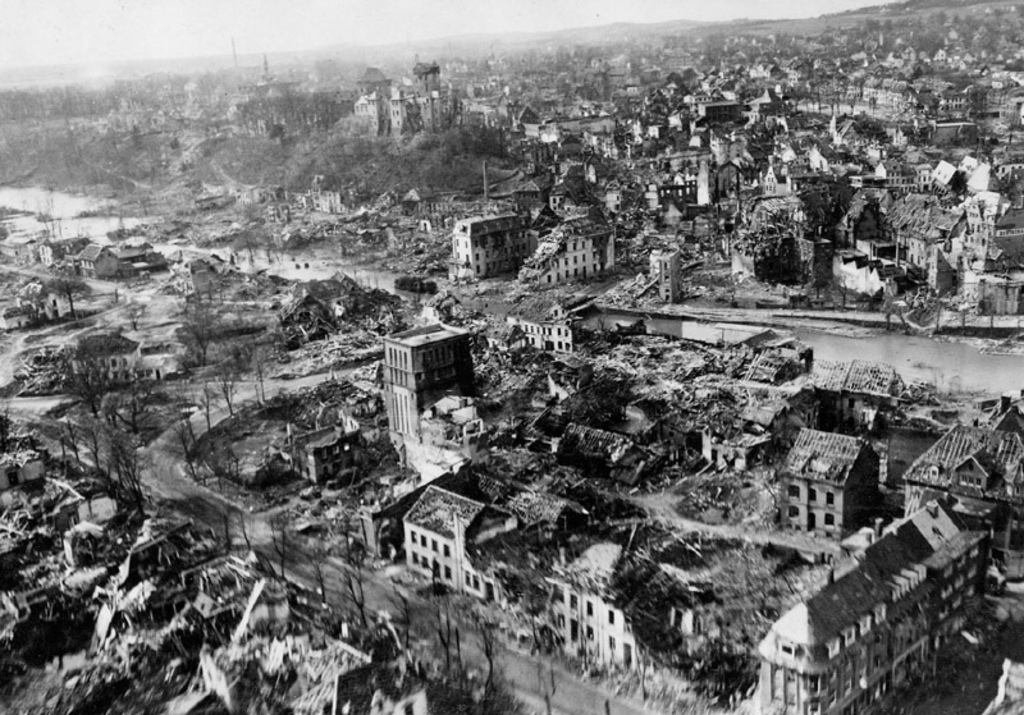
“It is probably better to kill a cross-section of the population than to kill only the young men.”.
Churchill's violence was on full display during the night of July 24, 1943. To the residents of Hamburg — a city of over one million souls — the raid seemed initially like a standard bombing run. But soon, hundreds of enemy aircraft began raining down tons of enemy aircraft began raining down tons upon tons of high explosives on the very heart of Hamburg. Schools, churches, hospitals, homes, ancient art and architecture, all were blown to bits. The onslaught increased in fury with each succeeding wave of bombers, building minute by minute into a fiery, devastating crescendo And then, the planes suddenly disappeared. The skies were clear again, and all above was silent. When the stunned survivors re-emerged from their cellars later that night, they saw that their once beautiful city was now a smouldering ruin. The following day, as firefighters from throughout northern Germany battled the blaze, Allied bombers suddenly appeared over Hamburg again. As planned, the Americans surprised not only the emergency workers, but columns of fleeing refugees as well. Thousands perished.
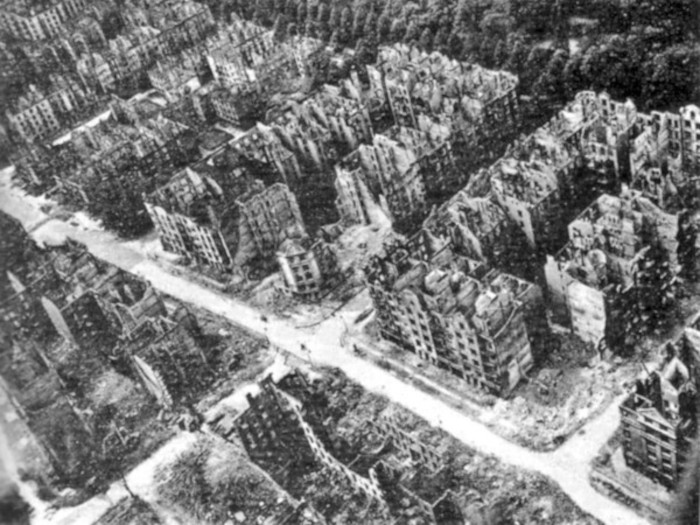
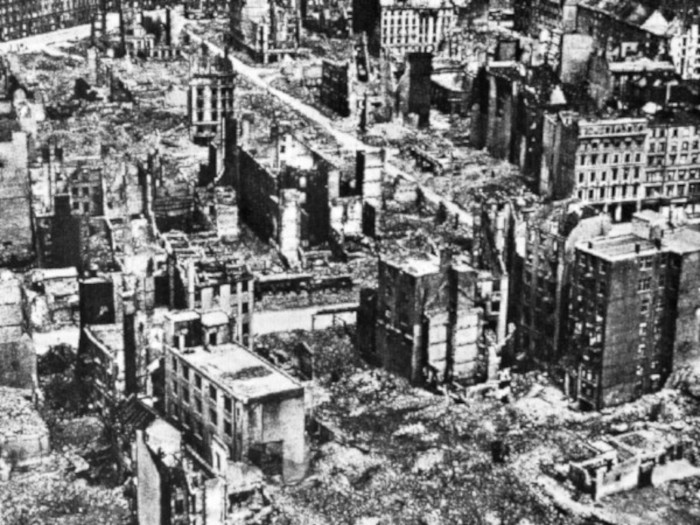
“Hitlers come and go, but Germany and the German people remain.”.
The next night, RAF bombers returned. In addition to the normal payload of high explosives, the British sent down tons of phosphorous bombs to accelerate the fires. The resulting conflagration ignited a “firestorm.” Hurricane-force winds created by the intense heat uprooted trees, ripped roofs from buildings and sucked screaming victims into the raging inferno. Some who escaped the 150 mph (241 kph) winds in the streets became mired in melting asphalt and quickly burst into flames. Those who had thrown themselves into the city's canals died of thermal radiation, then, as they floated on the water's surface, they too ignited. In the centre of the firestorm, temperatures reached 1,500 degrees Fahrenheit (816 C). When the great mass of flames joined, they rose into a column three miles high. The attacks against Hamburg continued unabated for another week. Soon, there was nothing left to destroy.
“a three-year period of deceit on the British public and world opinion.”.
Appropriately dubbed by the Allies as “Operation Gomorrah,” the raids had been a cold and calculated attempt to scorch Hamburg and its people, from the face of the earth. The plan succeeded. With thirteen square miles of total destruction, with 750,000 homeless, with an estimated 60 to 100,000 dead, mostly women and children, Hamburg, for all intents and purposes, had ceased to exist. It was now clear to all that the Allied air war against Germany had become a war of massacre and terror. The pattern was repeated time and again across Germany. All German cities suffered the same. After first blasting a town to splinters, the Allied bombers quickly returned in the hope of catching survivors and rescuers in the open and igniting with firebombs all that remained. When the roaring bombers released their lethal cargo, a veritable rain of fire descended upon a targeted town. The thousands of small fires would join together to form one huge blaze, creating an intense vortex of wind and flames.
Kate Hoffmeister: I struggled to run against the wind in the middle of the street. We couldn't go on across because the asphalt had melted. There were people on the roadway, some already dead, some still lying alive but stuck in the asphalt. They were on their hands and knees screaming. Some miraculously survived the inferno, reaching safety in rivers, canals, and parks. Thousands more, however, did not.
When the raids finally ended and the firestorms began to recede, rescue workers rushed to free those still trapped underground. When would-be rescuers finally broke through to buried bunkers, they often found scenes of unimaginable horror. In cellars suffering direct hits, walls were awash in blood, with bone, brains and body parts splattered everywhere. Rescuers who entered some bunkers found floors covered, in up to a foot of greasy fat, the victims rendered down into a dark liquid. When word first filtered through to the outside world of the butchery being visited upon the women and children of Germany by the Royal Air Force, critics of these war crimes spoke out Author Vera Brittain: The ruthless mass bombing of congested cities is as great a threat to the integrity of the human spirit as anything which has yet occurred on this planet. There is no military or political advantage which can justify this blasphemy. Although it was considered treasonous for members of the RAF to criticise the bombing campaign, the conscience of some was overwhelmed by the hell being unleashed upon Germany.
RAF Aviator: There were people down there being fried to death in melted asphalt in the roads, they were being burnt up, and we were shuffling incendiary bombs into this holocaust. I felt terribly sorry for the people in that fire I was helping to stoke up.
As a symbol of the Third Reich, and as the most obvious example of Germany's will to fight on, more bombs were devoted to Berlin than any other German city. It is another place; however, that has become most widely associated with the terror campaign waged against Germany — Dresden. Since Dresden had suffered only two small raids in the five years of war, many assumed that the cite's salvation was due to its irreplaceable treasures — ornate palaces, world-renowned museums and art galleries, its towering, centuries-old cathedrals. Others surmised that since Dresden had almost no heavy industry — and what little it did have had no bearing on the war — the enemy simply did not deem the city a viable target. To some, the twenty-six thousand Allied POWs interned within the town appeared a more logical answer.
Still others thought that, perhaps, it was the estimated half million refugees jamming the city, many who had fled Soviet atrocities in the East, that kept Dresden safe from bombing. Despite the dire situation as war closed in, Dresdeners were determined on the night of February 13 to enjoy an annual event, known in America as Mardi Gras, but celebrated in Germany as “Fashing.” Women and children, along with the few remaining men, many in costume, flooded the streets of Dresden to celebrate the event, one last time, before Germany's looming defeat. Just before ten p.m. sirens began wailing. There was no panic. Most residents simply ignored the sounds. Even had there been any air raid shelters few would have fled to them for there seemed little doubt on this cold, yet cheery night, that like the 171 false alarms which had preceded it, this warning too, would end in nothing.
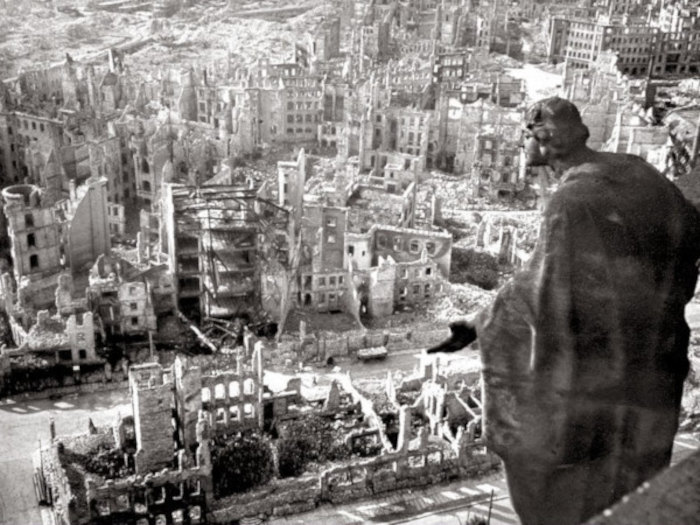
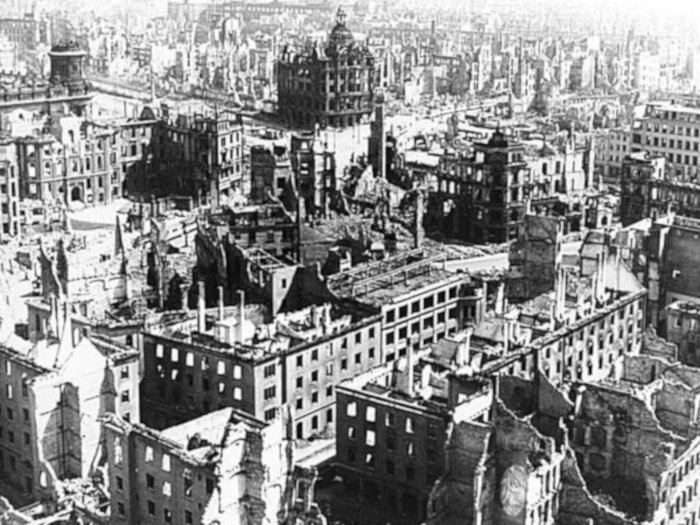
However, instead of the “All Clear” siren, a short time later Dresden heard another sound, a sound similar to a rolling earthquake. As wave after wave of RAF bombers appeared overhead, thousands of bombs tumbled down. Added to the normal payload of high explosives, hundreds of two- and four-ton “blockbuster” bombs slammed into Dresden, obliterating entire neighbourhoods.
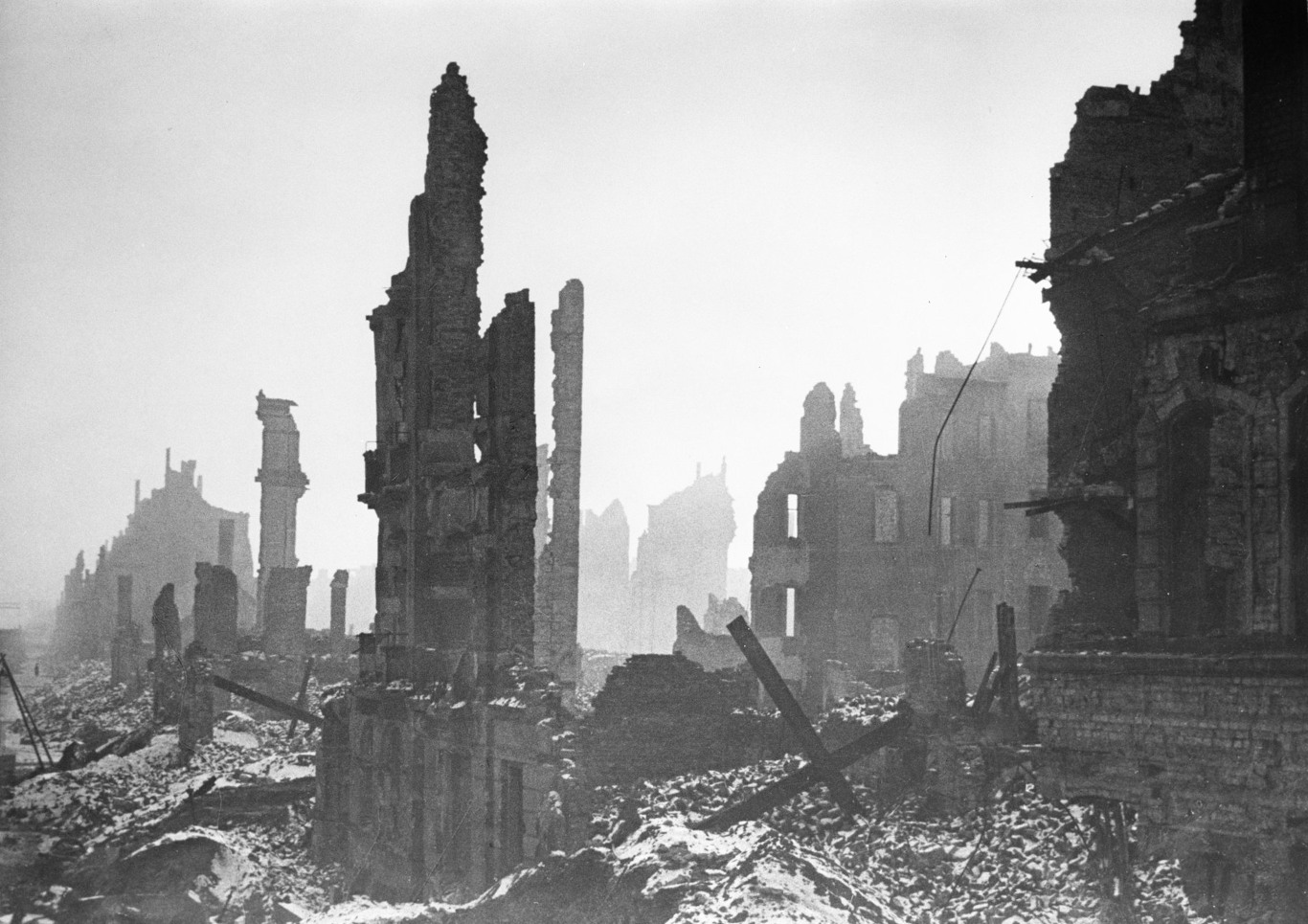
Ancient cathedrals, palaces, and museums were reduced to rubble within seconds. At the railroad station, hundreds of individuals who had refused to leave their highly coveted train seats were blown to bits. At the huge indoor circus, spectators, performers and animals were slaughtered by blast and hissing shrapnel. Well-marked hospitals were targeted. In the streets, on the side walks, atop the bridges over the Elbe River, costumed revellers with nowhere to run, were slain by the thousands.
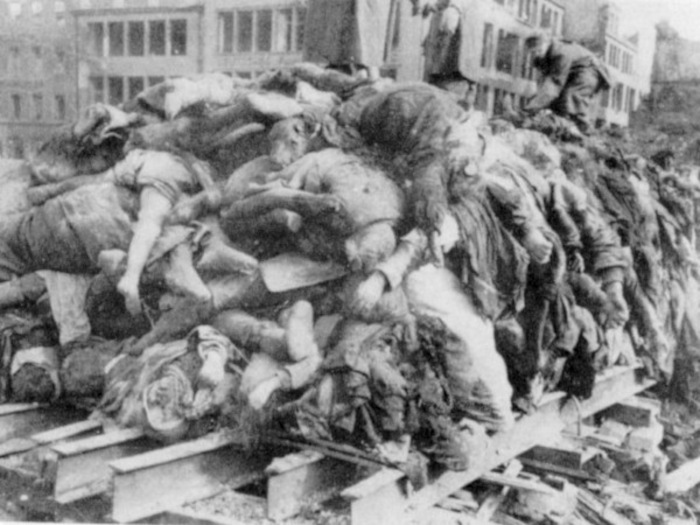
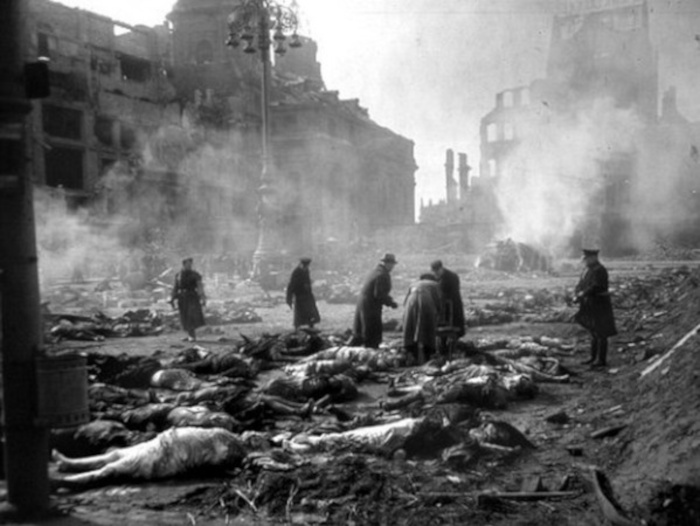
Without let-up, the massacre continued. And then, the roar above ceased, the explosions stopped, and there was quiet once more. Several minutes later, the welcomed silence was broken, by the even more welcome sound of the “All Clear” signal. What had seemed an all — night trial by fire had actually occurred in just under half an hour. In those thirty minutes, however, one of the world's most beautiful architectural treasures had all but vanished. Fire brigades from surrounding towns arrived. Red Cross workers spread out to help the victims. Families screamed for missing loved ones. For many, the end of the world had seemingly arrived. No one, however, was at all emotionally prepared for what came next…. At 1:30 a.m., the earth began to tremble once again. As more than a thousand bombers roared overhead, a rain of death showered down on Dresden.
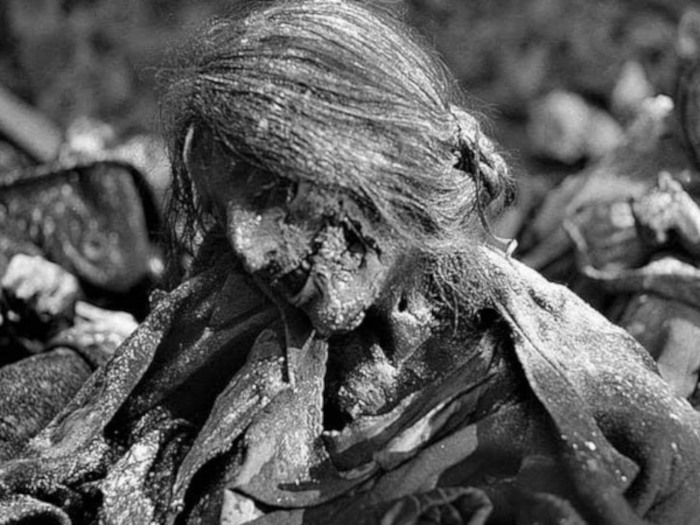
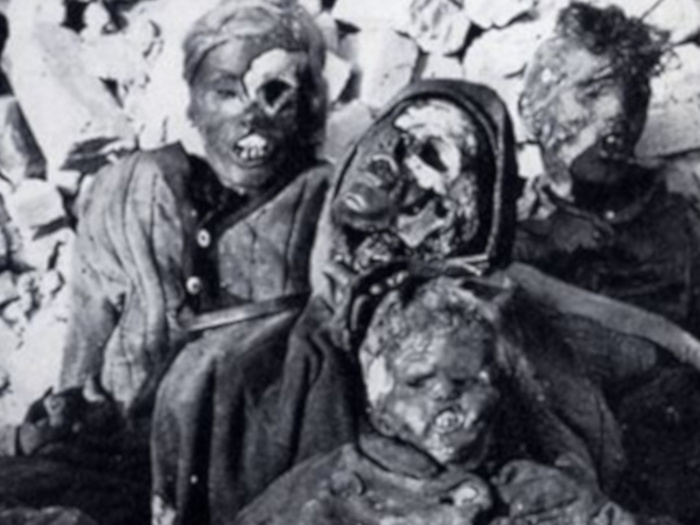
In addition to explosives, the second wave brought tons of incendiary bombs. In a matter of minutes, the thousands of firebombs ignited the debris and a racing furnace of flame erupted. Unfamiliar with the bombing raids and firestorms, most Dresdeners reacted slowly. Many sought safety in cellars again, not realising that the terrific heat would transform their havens into ovens. Others ran for safety through the streets, only to become mired in melting asphalt or sucked into the roaring furnace. Copper roofs melted, sending down streams of molten metal upon the people below. Throughout the night, the fiery hell that was Dresden claimed victims by the thousands, by the tens of thousands, and by the hundreds of thousands. The following day, when the fires had cooled, rescue workers went to work.
Rescue worker: Never would I have thought that death could come to so many people in so many different ways. Sometimes the victims looked like ordinary people apparently peacefully sleeping; the faces of others were racked with pain, the bodies stripped almost naked by the tornado; there were wretched refugees from the East clad only in rags, and people from the Opera in all their finery; here the victim was a shapeless slab, there a layer of ashes. Across the city, along the streets, wafted the unmistakable stench of decaying flesh. Indeed, of all the hideous scents wafting through Dresden — sulphur, gas, sewage — the heavy stench of cooked flesh blanketed all. What were at first mistaken to be thousands of burnt logs scattered about the streets were soon found to be charred corpses glued to the surface, each reduced to roughly three feet.Rescue worker: One shape I will never forget was the remains of what had apparently been a mother and a child. They had shrivelled and charred into one piece, and had been stuck rigidly to the asphalt. They had just been prised up. The child must have been underneath the mother because you could still clearly see its shape, with its mother's arms clasped around it. Aware that those in the old city would flee the flames to the open spaces, the RAF had hurled hundreds of high explosive bombs into the huge Central Park. Here, the slaughter was ghastly — torn-off limbs, mutilated torsos, heads blown from their bodies and hurled away. The nightmare was everywhere.
Red Cross Worker: I went down on my knees, trembled and cried. Several women lay there with their bellies burst open, and one could see the babies, for they were hanging half outside. Many of the babies were mutilated. Scenes like that one I saw everywhere, and very slowly one became numbed. One acted like a zombie. The next morning, word spread that survivors should assemble in the city park. As the suffering mass climbed over the debris and the dead, they reached the park, as well as the grassy banks of the Elbe. Some found missing loved ones. Most, however, did not. And then, shattering the calm, came the sounds once more — the roar of engines overhead.
As US bombers began blasting the rubble to dust, American fighter planes zeroed in on the thousands of refugees at the park, along the river and in other open spaces. Even zoo animals, which had miraculously managed to survive the bombing raids, were strafed and slaughtered. A weeping zookeeper watched as an American pilot chased down and shot his last remaining giraffe. Although the raid lasted only ten minutes, the Americans returned the next day, and the next, and the next, seemingly determined that not a single living thing should survive in Dresden. One of the horrors for those who had survived the nightmare was recovery of the dead. Initially, bodies were pitchforked onto trucks and wagons, and then take to shallow graves on the outskirts of Dresden. It soon became clear that such a slow process could never handle the enormous amount of bodies, so huge grills were fashioned from girders in various parts of town and corpses were stacked on them like logs. When the piles reached roughly ten feet high and thirty feet wide, flamethrowers were used to ignite the mass.

One month after the massacre, the Dresden Chief of Police reported that over 200,000 bodies had been recovered from the ruins. Later, the International Red Cross estimated that 275,000 had died in the raids. Because of the incredible density of Dresdens population on the night of February 13th 14th because thousands of victims were refugees with no records, and because many bodies either lay buried forever in the ruins or had simply melted like wax, other estimates, which place the death toll at 300,000 to 400,000 may well be closer to the mark. More people died during the firebombing of Dresden than during the nuclear bombings of Hiroshima and Nagasaki combined.
RAF crewman: To just fly over it without opposition felt like murder. I felt it was a cowardly war. Working in tandem with the terror bombing of German cities was the “targets of opportunity” policy upon the countryside. Under this order, anything moving in the Reich was fair game for Allied fighter planes. Ships, trucks, cars, trains, ambulances, women shopping on bicycles, farmers in fields, animals in pastures, even children in school yards, were targets of Allied aircraft. In a flagrant attempt to widen the war, American bombers even attacked Zurich, Basel, and other targets in neutral Switzerland. Additionally, Winston Churchill made plans to saturate German cities with poison gas and kill those women and children yet alive amid the rubble. When advisers pointed out that Adolf Hitler might reply in kind with his own stockpiles of chemical weapons, the murderous plan was shelved. Meanwhile, the hell raining from the clouds mirrored an ongoing hell rising from the mud. As Germans soon came to realise, the Allied powers sought not only the physical destruction of Germany, but the spiritual massacre of the nation as well.
Recommended reading: The jewish Holocaust of Germans: Operation Gomorrah.
THE RAPE OF GERMANY
The evil swept in from the East. There were constant rumours and hints about what might be expected should the Soviet Union overrun Germany. Most Germans, however, remained hopeful. Such notions of “Asiatic hordes”, many felt, were merely the government's attempt to harden their will to resist. Thus, it was, that on the night of October 20th, 1944, as the village of Nemmersdorf and other communities nearest the front slept in imagined security, the unthinkable occurred. After punching a hole through the German line, the Red Army suddenly burst into the Reich and swarmed over the countryside. After several days of desperate fighting, the German Wehrmacht regrouped, launched a furious counter-attack, and eventually drove the Red Army across the border. What German troops soon found was staggering. It was at Nemmersdorf where stunned soldiers first viewed hell on earth. Along the roads, fleeing refugees had been overtaken by the communists; the people were pulled from their carts, raped, then murdered on the spot.
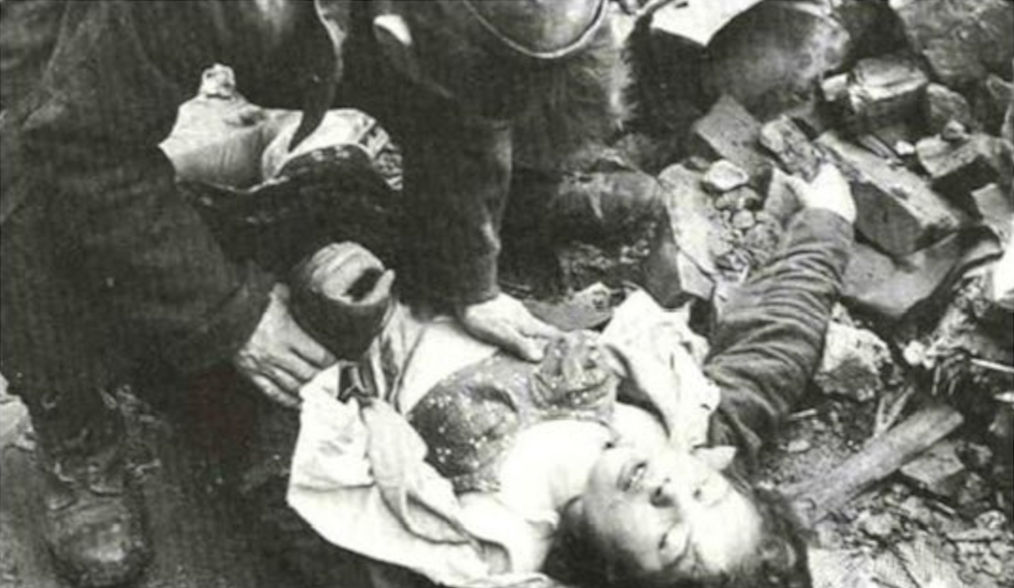
“The exact number of German women and girls raped by Soviet troops during the war and occupation is uncertain, but historians estimate their numbers are likely in the hundreds of thousands, and possibly as many as two million.”.
A witness: In the farmyard further down the road stood a cart, to which four naked women were nailed through their hands in a cruciform position. Beyond stood a barn and to each of its two doors a naked woman was nailed through the hands, in a crucified posture. In the dwellings we found a total of seventy-two women, including children, and one old man, 74, all dead, all murdered in a bestial manner, except only a few who had bullet holes in their necks. Some babies had their heads bashed in. In one room we found a woman, 84 years old, sitting on a sofa, half of whose head had been sheared off with an axe or a spade. Old men who had tried to protect their wives, daughters and granddaughters, were themselves knocked down, then sawed in half. Fifty French POWs and Polish workers who had instinctively stepped in to protect the people were castrated and killed.
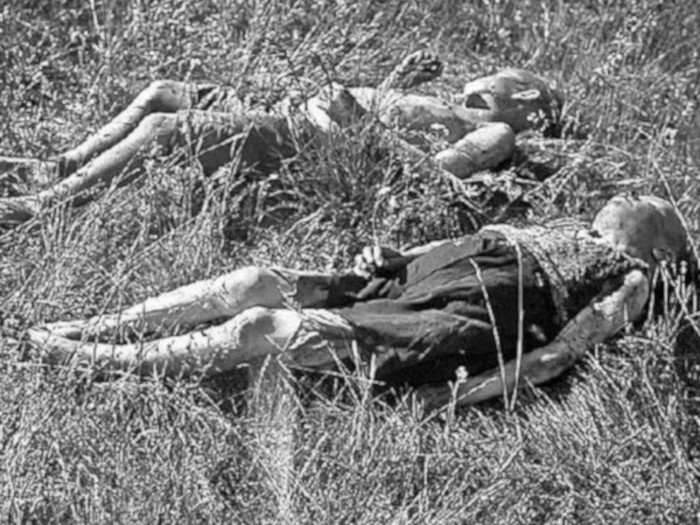
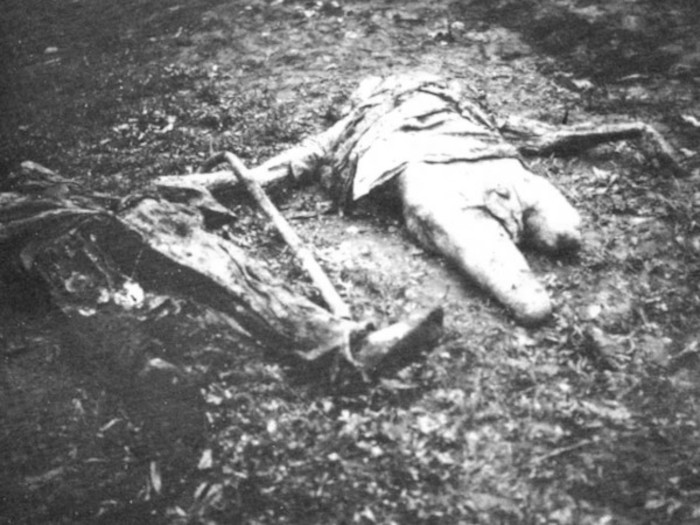
Staggered by the enormity of the crime, German authorities requested that neutral observers from Spain, Sweden, and Switzerland view the sickening carnage close up. However, when the visitors filed their reports and word finally reached the outside world, there was only silence. By the winter of 1944, the vicious propaganda war waged against Germany had been won. By that late stage of the conflict, the war of words had reached such evil extremes that few individuals beyond the Reichs borders were concerned about brained German babies or crucified German women. By the final months of the war, the enemy to be destroyed was not merely Adolf Hitler, the Nazi Party or even the soldiers in the field. By the final months of the war, the aim of the approaching Allies was nothing less than the utter extinction of the German nation — every man, every woman, every child.
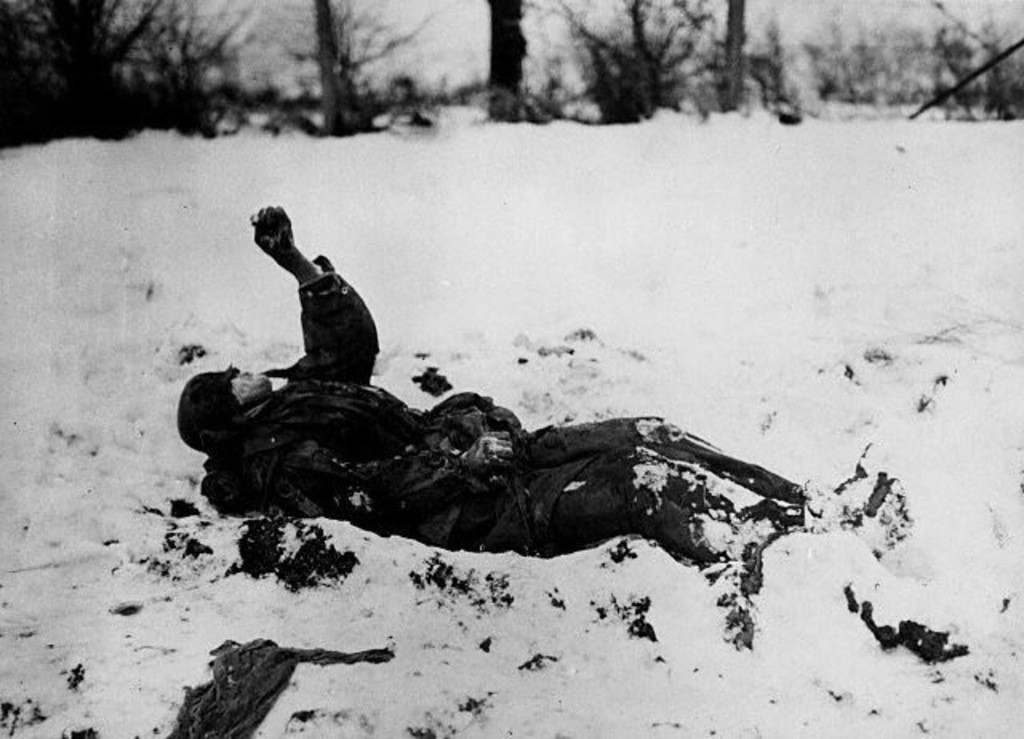
“We would have to break the joints to give the dead a natural posture.”.
Fuelling the flames of hate was the Jewish propagandist Ilya Ehrenburg. One of the most influential men in the Soviet Union, Ehrenburg made sure his message of evil reached every soldier in the Red Army by ordering that leaflets be dropped from airplanes onto the front lines. Ehrenburg's directive: Kill them all, men, old men, children and the women, after you have amused yourself with them! Kill. Nothing in Germany is guiltless, neither the living nor the yet unborn. Break the racial pride of the German woman. Take her as your legitimate booty. Kill, you brave soldiers of the victorious Soviet Army. Soon, as the Red Army forced the Wehrmacht back in the east, millions of German civilians suffered the same ghastly fate as the victims of Nemmesdorf. Although first encounters with Soviet shock troops were truly traumatic, it was the second wave of soldiers who delivered hell on earth.
In numerous instances, before troops pushed on, they turned to the helpless civilians and warned: The Mongols are coming. Very bad men. You go quick. Go quick. Terrified by the news, many Germans did attempt to flee. Most, however, found themselves trapped. Other than destroy liquor and hide young girls, most could only watch the clock and pray that their worst fears were unfounded. After a wait of sometimes days, but normally hours, the dreaded second wave arrived. Composed largely of Mongols and other Asians, as well as convicts, these men who formed the second wave of troops were regarded, even by their own comrades, as utterly merciless. Leading this group were the Communist commissars, the fanatical political officers composed almost exclusively of Jews. These hate- filled individuals acted as the more-than- willing orchestrator's of the horrors that befell the German people. Of all the methods used to express its hatred, the Red Army said it best with rape.
Rape Survivor: And when the first Russians came, the combat troops, they came in and wanted to see everything, asked about weapons, and soldiers, looked at everything closely, didn't find anything, and were very friendly, and just left. Then the next lot arrived. The next one took me outside straight away. My mother wanted to throw herself in front of me, but she was pushed back. And then they took me upstairs, and as I tried to defend myself, he showed me his gun. And then when I came back down, I was… well, shocked, but I was just happy that I was still alive. They said, “Woman, come!” They said it in German, “Frau kommen!” in German. We were the prize. It was always like that. From eight to eighty years old, healthy or ill, indoors or out, in fields, on side-walks, against walls, the defilement, torture, and murder of German women continued unabated. Merely because a female had been raped once was also no guarantee she would not be assaulted again… and again… and again.
A victim: The Russians were coming and going the whole time, and they kept eyeing us greedily. The nights were dreadful because we were never safe for a moment. The women were raped, not once or twice but ten, twenty, thirty and a hundred times, and it was all the same to the Russians whether they raped mere children or old women. The youngest victim in the row houses where we lived was ten years of age, and the oldest one was over seventy. The women of Germany not only had to endure this onslaught of rape, torture, and murder, but also, the humiliation of having it witnessed by friends and family.
A witness: These atrocities were not committed secretly or in hidden corners but in public, in churches, on the streets, and on the squares. Mothers were raped in the presence of their children, girls were raped in front of their brothers. When even violated corpses could no longer be of use, sticks, iron bars and telephone receivers were commonly rammed into their vaginas. Jewish commissars had a special desire to defile the churches of Germany. Soon after the fall of Danzig, hundreds of desperate females pleaded with an officer for protection. The Soviet pointed to a Catholic cathedral. After the women were safely inside, the officer yelled to his men, pointed to the church, and with bells ringing and organ pipes roaring the horror continued all night. Some women and girls inside, some as young as 8 years old, were raped more than thirty times. Little boys who tried to shield their mothers were shot.
When Soviet soldiers captured the city of Neustettin in February 1945, they discovered several large camps of the Women's Reich Labour Service, an organisation composed mostly of girls who worked on various projects from nursing to street repair. After re-capturing the area, the German soldiers were horrified by what had happened to the 2,500 females.
German soldier: We had never seen anything like it — utterly, unbelievably monstrous! Naked, dead women lay in many of the rooms. Swastikas had been cut into their abdomens, in some the intestines bulged out, breasts were cut up, faces beaten to a pulp and swollen puffy. Others had been tied to the furniture by their hands and feet, and massacred. A broomstick protruded from the vagina of one, a besom from that of another. The mothers had to witness how their ten and twelve-year-old daughters were raped by some 20 men; the daughters in turn saw their mothers being raped, even their grandmothers. Women who tried to resist were brutally tortured to death. There was no mercy.
The women we liberated were in a state almost impossible to describe. Their faces had a confused, vacant look. Some were beyond speaking to, ran up and down and moaned the same sentences over and over again. Having seen the consequences of these bestial atrocities, we were terribly agitated and determined to fight. We knew the war was past winning; but it was our obligation and sacred duty to fight to the very last bullet. While its men fought furiously in the East, Germany was also trying to stave off invasion from the West. Unfortunately, the invaders on this front often did not behave any better than their Soviet Allies; battlefield newsmen to the west simply did not report the crimes. As tens of thousands of German rape victims could attest, there was no safety among the American and British.
“After the fighting moved on to German soil, there was a good deal of rape by combat troops and those immediately following them. The incidence varied between unit and unit according to the attitude of the commanding officer. In some cases offenders were identified, tried by court-martial, and punished. The army legal branch was reticent, but admitted that for brutal or perverted sexual offences against German women, some soldiers had been shot — particularly if they happened to be Negroes. Yet, I know for a fact that many women were raped by white Americans. No action was taken against the culprits. In one sector, a report went round that a certain very distinguished army commander made the wisecrack, 'Copulation without conversation does not constitute fraternisation.”.
[In 2015, the German news magazine Der Spiegel reported that German historian Miriam Gebhardt “believes that members of the US military raped as many as 190,000 German women by the time West Germany regained sovereignty in 1955, with most of the assaults taking place in the months immediately following the US invasion of NSDAP Germany. The author bases her claims in large part on reports kept by Bavarian priests in the summer of 1945.”]
Millions massacred, millions raped, millions already enslaved, but this was only the beginning of Germany's nightmare.
THE BALTIC MASSACRE
With the German army in headlong retreat, hordes of Red soldiers swarmed into Greater Germany during the last winter of the war. As word of the Soviet breakthrough spread, millions of Germans hastily packed and fled into the freezing weather. Most merely packed farm carts, hitched horses or cows, and set off as fast as their animals would take them. Already bitterly cold, several days after the “treks” began, the temperature plunged. As a result, little children and infants dropped by the thousands. With the earth hard as rock, tiny holes dug in the snow banks served as graves.
A young mother: It was so terribly cold, and the wind was like ice the snow was falling and nothing warm to eat, no milk and nothing. I tried to give Gabi the breast, behind a house, but she didn't take it because everything was so cold. Many women tried that, and some froze their breasts. Given the chaotic conditions, and with freezing refugees clogging the way, many treks were quickly overhauled by the Russians. Some Soviet tanks crashed straight through the columns, squashing all in their path. After heavy traffic, the victims — men, women, children, animals, all — were pressed together as flat as cardboard. Those terrified survivors who had scattered to the icy countryside fell easy prey. As always, for females, the living death soon began. For millions of Germans cut off on the Baltic coast, only one avenue of escape remained — the sea. As isolated Wehrmacht units desperately defended their shrinking Baltic beach-heads, millions of refugees poured into the coastal enclaves. With their backs literally to the sea, only the slow and treacherous evacuation by boat was an option. Consequently, at Memel, Konigsberg, Danzig, and other besieged cauldrons, the situation was appalling.
Juergen Thorwald: Every alley, every street was packed with their vehicles. People were waiting in every harbour shed, in every wind — sheltered corner. Among them stood their beasts, bleating, snorting, lowing. The pregnant women giving birth somewhere in a corner, on the ground, in a barracks. Some of them had been raped on their flight, and now they were trembling for fear they would give birth to a monster. The strangely pale faces of girls going up and down the streets asking for a doctor. The wounded and the sick, in constant fear they would be left behind, concealing weapons under their blankets to force someone to take them along, or to end their own lives if the Russians came. The orphans who had been saved from their asylum somewhere at the last moment and tossed onto carts with nothing around them but a blanket, and who were now lying on the floors with frozen limbs. The old people who had lain down in some doorway at night, and had not awakened. And the wild-eyed insane ones who rushed from house to house, from wagon to wagon, crying for their mothers or their children. Over it all the gray sky, snow, frost, and thaw… and thaw and frost and snow, and the chill, killing wet.
When a long-sought vessel finally tied up and lowered the walkways, pandemonium erupted on the docks. Because of an order granting priority to those with children, the latter became more valuable than gold. Once adults had boarded, they often tossed infants to relatives or friends below in hopes they might also board. Many babies died, of course, either falling into the freezing water or smashing onto the docks below. Nearby, terribly wounded soldiers quietly awaited their turn to board. For those who sailed from the besieged ports, their prayers appeared answered; for those left standing behind, their doom seemed sealed. Many men, “in a surge of madness,” shot themselves.
Crazed mothers, with starvation gnawing and the red terror looming, found cyanide and poisoned their children, then themselves. Old people merely crawled into snow banks, fell asleep, and never awoke. Unfortunately, for thousands of refugees, there was no escaping the nightmare, even at sea. While many refugee ships successfully traversed the treacherous Baltic, Allied bombers were often the first to greet them when they docked. At Swinemunde in northern Germany, the arrival of a freighter loaded with evacuees coincided almost exactly with an Allied air raid. Hardly had the ship docked when a direct hit sent it to the bottom, taking 2,000 screaming passengers with it.
On January 30, 1945, over 60,000 refugees crowded the docks of Gotenhafen, desperately trying to board the Wilhelm Gustloff, a former cruise liner designed to accommodate two thousand passengers and crew. By the time the beautiful white ship cast off, she had taken on as many as six to eight thousand refugees. As the Gustloff backed away from the port, her path was blocked by smaller craft, all jammed with passengers begging to come aboard. Nets were lowered, and an additional two thousand refugees scrambled up. Strained far beyond its limits, the tightly-sealed ship filled with a hot, nauseating stench of urine, excrement, and vomit. The groans of severely wounded soldiers and the screams of separated families added to the ghastly horror. But the worst was yet to come.
At approximately 9 p.m., three heavy thuds rocked the Gustloff. Panic-stricken, thousands below deck stampeded through the narrow passageways, crushing and clawing in a mad attempt to reach safety. Most lifeboats were frozen solid, and even those that could be freed were mishandled in the panic, spilling their screaming occupants into the icy Black Sea. Within a few minutes, those in the water were dead. While thousands of freezing people pressed along the decks, loudspeakers blared words of comfort, assuring passengers that the ship would not sink and help was on the way. Convinced that the sealed bulkheads had held and that, indeed, the ship would remain afloat, many refugees fled indoors once more to escape the razor sharp winds and 20 degrees (-29 C) temperature.
The respite proved brief, however. At ten o'clock, a heavy tremor ripped the Gustloff as the bulkheads broke, and the sea rushed in. Within seconds, the big ship began to roll on its side, then plunged beneath the waves. When rescue ships later reached the scene, they pulled from the icy waters a mere nine hundred survivors. All else — roughly seven to nine thousand men, women and children — were lost. As many more incidents would prove, the sinking of the Gustloff was no mistake. In a deliberate attempt to kill as many refugees as possible, Soviet submarines struck again and again at the slow-moving ships. Soon after midnight on February 10th, an old luxury liner, the General Stueben, was ploughing through the icy, black Baltic. Heavily weighed down with refugees and wounded soldiers, the ship was in the midst of its second such evacuation in less than a fortnight. Just before one a.m., two torpedoes slammed into the ship's side. As the Stuebens stern rose high out of the water, hundreds leaped overboard, including some who were torn to pieces by the still-turning propellers. Within seven minutes, the ship plunged beneath the waves, swiftly silencing a final mass scream that seemed to arise from a single voice. Of the 3,500 passengers aboard, only a few hundred survived.
Goodrich: Like some great wild animal, the Red Army moved closer to the heart of Germany. In countless German cities and towns, the pattern repeated itself. The bloody nightmare which enveloped the Baltic coast was typical of that which transpired wherever the Soviets occupied German soil. In many places — Silesia, Prussia, Pomerania, in the German communities of Czechoslovakia, Jugoslavia, Poland, Hungary — a similar horror had been in progress for weeks. There, the ghastly atrocities actually increased, as if Red soldiers were in a mad race with one another to see who could destroy, murder and, above all, who could rape the most. Meanwhile, the American and British forces punched through the German lines in the West. Unlike the East Front, however, German soldiers were well aware that the foes they faced in the west were signatories of the Geneva Convention. Under this agreement, captured or surrendering German soldiers were protected by law. With the Red Army roaring across Germany from the east, many Germans secretly hoped that the Americans might occupy what remained of the Reich before the communists did. It was no secret that Germans, high and low, considered the Americans and British the lesser of two evils. Unfortunately, they were not always right.